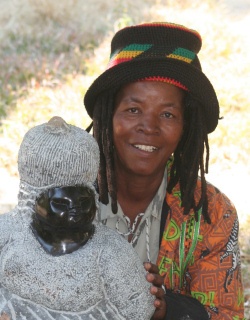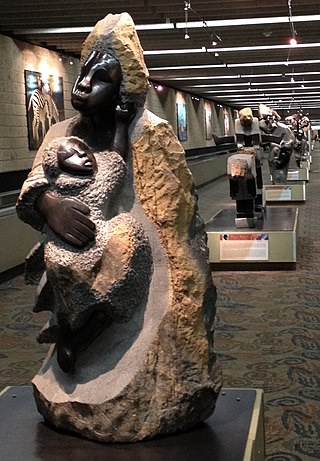Related Research Articles
Francis Jack McEwen, OBE was an English artist, teacher, and museum administrator. He is best remembered today for his efforts to bring attention to the work of Shona artists in Rhodesia, and for helping to found the National Gallery of Zimbabwe. He was awarded the OBE in 1963.
Thomas Mukarobgwa (1924–1999) was a Zimbabwean painter and sculptor who worked as a gallery attendant for much of his career.

The Chapungu Sculpture Park is a sculpture park in Msasa, Harare, Zimbabwe, which displays the work of Zimbabwean stone sculptors. It was founded in 1970 by Roy Guthrie, who was instrumental in promoting the work of its sculptors worldwide. One way this was done was by exhibiting the sculptures in Botanical Gardens in a touring exhibition called "Chapungu: Custom and Legend — A Culture in Stone". The places visited include:
Nicholas Mukomberanwa was a Zimbabwean sculptor and art teacher. He was among the most famous protégés of the Workshop School at the National Gallery of Zimbabwe. He was a mentor to the Mukomberanwa Family of sculptors. Mukomberanwa married his first wife, sculptor Grace, in 1965 and they had eight children. In 1965, he decided to end his career with the police to become a sculptor full-time. He continued to hone his skills over the following decade, developing one of the most distinctive personal styles found in his generation of Zimbabwean stone sculptors. The gambit paid off, and by the late 1970s and in the 1980s his work was being shown in many venues. His work has been exhibited in galleries around the world. He also became mentor to many artists in Zimbabwe, including his children Anderson Mukomberanwa, Ennica Mukomberanwa, Lawrence Mukomberanwa, Netsai Mukomberanwa, Taguma Mukomberanwa,Tendai Mukomberanwa and nephew, Nesbert Mukomberanwa who are also sculptors. He remains one of Zimbabwe's most famous artists.
Bernard Matemera was a Zimbabwean sculptor. The sculptural movement of which he was part is usually referred to as "Shona sculpture", although some of its recognised members are not ethnically Shona. His whole professional career was spent at the Tengenenge Sculpture Community, 150 km north of Harare near Guruve.
Boira Mteki was a Zimbabwean sculptor.

Joram Mariga has been called the “Father of Zimbabwean Sculpture” because of his influence on the local artistic community starting in the 1950s and continuing until his death in 2000. The sculptural movement of which he was part is usually referred to as “Shona sculpture”, although some of its recognised members are not ethnically Shona.

Henry Munyaradzi, also known as Henry Munyaradzi Mudzengerere, was a Zimbabwean sculptor. The sculptural movement of which he was part is usually referred to as "Shona sculpture", although some of its recognised members are not ethnically Shona. He worked initially at the Tengenenge Sculpture Community, 150 km north of Harare near Guruve, which he joined in 1967. In that Community, and ultimately in the wider world of lovers of Zimbabwean art, he was known simply as 'Henry'.
Square Chikwanda is a Zimbabwean sculptor, living and working in Harare, Zimbabwe. He first learned his art from his father, also a Zimbabwean sculptor.
Joseph Ndandarika was a Zimbabwean sculptor known for his figurative works.

Colleen Madamombe was a Zimbabwean sculptor working primarily in stone. Her work expresses themes of womanhood, motherhood, and tribal Matriarchy.
Fanizani Akuda, also known as Fanizani Phiri, was a member of the sculptural movement usually called "Shona sculpture", although he and some others of its recognised members were not ethnically Shona. He worked initially at the Tengenenge Sculpture Community, 150 km north of Harare near Guruve, which he joined in 1966.
Crispen Chakanyuka was a Zimbabwean sculptor.
Bernard Takawira (1948–1997) was a Zimbabwean sculptor, the younger brother of John Takawira and older brother of Lazarus Takawira.
Sylvester Mubayi was a Zimbabwean sculptor.

Agnes Nyanhongo is a Zimbabwean stone sculptor.

Samuel Songo was a Rhodesian artist., known for his works depicting African iconography and traditional African life. Songo was disabled and used a wheelchair. He spent most of his life working through the Cyrene Mission School, producing art on the behest of Frank McEwen, a British expatriate who helped establish and later ran the Rhodesian National Gallery of Art. Songo's early work consisted of occasional paintings and sculpture, however, in later years, he worked almost exclusively in the classic traditions of Shona stone sculpture.

Sculpture and in particular stone sculpture is an art for which Zimbabwe is well known around the world.
Celia Winter-Irving, was an Australian-born, Zimbabwean-based artist and art critic who wrote extensively on Zimbabwean art, especially Shona sculpture, when she lived in Harare from 1987 to 2008.

Tengenenge is a community of artists and their families located in the Guruve District of Zimbabwe. It has achieved international recognition because of the large number of sculptors who have lived and worked there since 1966. These include Fanizani Akuda, Bernard Matemera, Sylvester Mubayi, Henry Munyaradzi and Bernard Takawira.
References
- ↑ Biography on National Gallery website [ permanent dead link ]
- ↑ Sultan, O. (1994) Life in Stone: Zimbabwean Sculpture – Birth of a Contemporary Art Form, Baobab Books, Harare. ISBN 978-1-77909-023-2
- ↑ McEwen F. (1972) Shona Art Today African Arts Vol. 5, No. 4 pp. 8-11
- ↑ Contemporary Stone Carving from Zimbabwe, 1990, ISBN 1-871480-04-3
- ↑ Zilberg J. (2006) National Gallery Archive [ permanent dead link ]
- ↑ "McEwen Collection". britishmuseum.org. Retrieved 2012-01-25.
- ↑ Marian Botsford Fraser (2004). "The House of Stone" in "In Praise of Women" pp 65-68, African Millennium Foundation ISBN 0-620-32129-6
- ↑ Shona Queen (1987)
- ↑ Winter-Irving C.(1991) Stone Sculpture in Zimbabwe: Context, Content & Form, Roblaw Publishers, Harare, ISBN 0-908309-14-7 (Paperback) ISBN 0-908309-11-2 (Cloth bound)
- ↑ The Herald newspaper, Harare, 6-Sep-1988
- ↑ Catalogue published by Chapungu Sculpture Park, 2000, 136pp printed in full colour, with photographs by Jerry Hardman-Jones and text by Roy Guthrie (no ISBN)
- ↑ Joosten B (2001), Sculptors from Zimbabwe, the first generation, Nijmege Printers, The Netherlands,